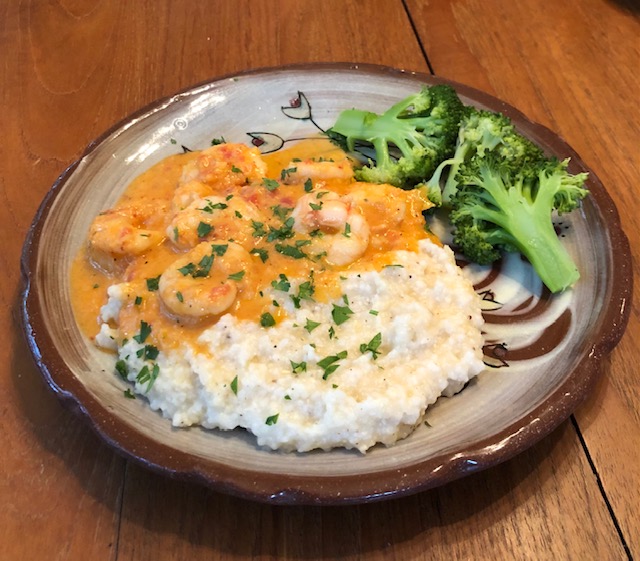Shrimp and Grits, or Smoked Salmon and Grits
I was introduced to Shrimp and Grits
by a friend originally from South Carolina, and have subsequently enjoyed it
(though occasionally – it tends to be pricey!) at a number of restaurants. The
biggest influence on how I myself prepare the dish came from the “Wahoo! Grill”
in Decatur, GA, back when we lived in Atlanta. I learned somewhat accidentally
what the subtle but unusual seasonings were that they used in their especially
delicious sauce. Those are in my recipe but I won’t point them out. The Grill
is still open and still features “Charleston Shrimp and Grits” on their
website. Thus my recipe contains their secrets masked among the seasonings that
I came up with on my own.
I’ve also used this same sauce that
the shrimp are cooked in to make my special variant, Smoked Salmon and Grits,
which you won’t even find on Google. Smoked salmon is more readily available
than fresh coastal shrimp. And it’s easier to work with than shrimp, with no
peeling or de-veining. I find I like the salmon version even more than the
shrimp original. But for the shrimp
version, good-quality frozen shrimp will work, though they’re not quite as
fine, or as elegant, as fresh-caught Georgia or South Carolina shrimp.
The shrimp and their sauce, or the
smoked salmon and its sauce, are designed to go over seasoned “dinner” grits. I
have a recipe for such grits in the blog post published just before this one.
The seafood over grits is fairly complicated to make. I recommend trying it for
family at least once before offering it to invited guests.
The recipe serves four to six people.
A simple vegetable and a green salad are good accompaniments as are warm dinner
rolls or baguette. Since it’s a “company” dish, I’ll mention that my wine
paring for either the shrimp or smoked salmon version would be a slightly
chilled (yes, chilled) Pinot Noir, or a well-chilled French rosé, California
Viognier or unoaked Chardonnay.
Shrimp and Grits or Smoked Salmon and
Grits
For one batch of seasoned “dinner”
grits (see my blog post of 7/30/23), kept hot while finishing the shrimp or
smoked salmon topping:
Shrimp Version
1 1/2
pounds fresh or frozen unpeeled large shrimp
or
1 pound large frozen peeled, de-veined shrimp
Thaw shrimp if frozen, in a colander
under cold running water. Let drain. If shrimp are unpeeled, peel and de-vein
them and rinse again. Set aside for later use. Refrigerate if holding for more
than half an hour before serving time.
Smoked Salmon Version
14-16 ounces smoked salmon, cut
coarsely into 1-inch pieces, and set aside till serving time.
Sauce for either version
1 small-medium onion, cut in large
pieces
1/2 red bell pepper, seeds removed
2-inch length of celery stick, cut in
half
1 medium-large clove of garlic
3 tablespoons butter
5 teaspoons sherry
1/4 cup white wine
1/2 cup canned crushed tomato
3/4 teaspoon Thai Panang curry paste
(freeze the remainder of the can for other use), optional
3/4 teaspoon salt if for shrimp, 1/2
teaspoon if using smoked salmon
1/2 teaspoon sugar
Large pinch ground fenugreek, if
available, or nutmeg
Large pinch black pepper
Large pinch cayenne
1/2 cup heavy cream
1/2 cup water, plus more as needed
Minced parsley for garnishing
Thoroughly puree the onion, bell
pepper, celery and garlic in food processor. Place in heavy pan with the butter
and fry gently over low heat, stirring frequently, until softened, 5 minutes or
more.
While that mixture is cooking, combine
the sherry, white wine, tomato, and the seasonings. When the onion mixture is
softened, add the tomato mixture and simmer another five minutes, stirring
occasionally. Stir in the cream and water, bring to a boil and simmer 2-3
minutes. The sauce can be made ahead to this point and held until dinner time.
If using shrimp: Ten minutes before
serving, reheat the sauce. Add the shrimp and with nearly constant stirring
heat them in the sauce until they curl up and get firm, 3-5 minutes. Do not
over cook. Remove from the heat. Taste the sauce and add a little salt if
needed.
If using salmon: Five minutes before
serving, reheat the sauce. Add the salmon pieces and stir and heat just until
hot. Add a little water if mixture is dry. Remove from the heat. Taste the
sauce and add a little salt if needed.
Serve on dinner plates. Place a bed of
hot grits, slightly spread out, and spoon the shrimp or smoked salmon mixture
partially over it, leaving some grits exposed. Sprinkle with a little minced
parsley for garnish.
Serve accompanied by a simple
vegetable, a green salad, plus some warm bread or dinner roll if desired.










